Jie Shen
Attribute-Efficient PAC Learning of Sparse Halfspaces with Constant Malicious Noise Rate
May 27, 2025Abstract:Attribute-efficient learning of sparse halfspaces has been a fundamental problem in machine learning theory. In recent years, machine learning algorithms are faced with prevalent data corruptions or even adversarial attacks. It is of central interest to design efficient algorithms that are robust to noise corruptions. In this paper, we consider that there exists a constant amount of malicious noise in the data and the goal is to learn an underlying $s$-sparse halfspace $w^* \in \mathbb{R}^d$ with $\text{poly}(s,\log d)$ samples. Specifically, we follow a recent line of works and assume that the underlying distribution satisfies a certain concentration condition and a margin condition at the same time. Under such conditions, we show that attribute-efficiency can be achieved by simple variants to existing hinge loss minimization programs. Our key contribution includes: 1) an attribute-efficient PAC learning algorithm that works under constant malicious noise rate; 2) a new gradient analysis that carefully handles the sparsity constraint in hinge loss minimization.
MIMIC-\RNum{4}-Ext-22MCTS: A 22 Millions-Event Temporal Clinical Time-Series Dataset with Relative Timestamp for Risk Prediction
May 01, 2025Abstract:Clinical risk prediction based on machine learning algorithms plays a vital role in modern healthcare. A crucial component in developing a reliable prediction model is collecting high-quality time series clinical events. In this work, we release such a dataset that consists of 22,588,586 Clinical Time Series events, which we term MIMIC-\RNum{4}-Ext-22MCTS. Our source data are discharge summaries selected from the well-known yet unstructured MIMIC-IV-Note \cite{Johnson2023-pg}. We then extract clinical events as short text span from the discharge summaries, along with the timestamps of these events as temporal information. The general-purpose MIMIC-IV-Note pose specific challenges for our work: it turns out that the discharge summaries are too lengthy for typical natural language models to process, and the clinical events of interest often are not accompanied with explicit timestamps. Therefore, we propose a new framework that works as follows: 1) we break each discharge summary into manageably small text chunks; 2) we apply contextual BM25 and contextual semantic search to retrieve chunks that have a high potential of containing clinical events; and 3) we carefully design prompts to teach the recently released Llama-3.1-8B \cite{touvron2023llama} model to identify or infer temporal information of the chunks. We show that the obtained dataset is so informative and transparent that standard models fine-tuned on our dataset are achieving significant improvements in healthcare applications. In particular, the BERT model fine-tuned based on our dataset achieves 10\% improvement in accuracy on medical question answering task, and 3\% improvement in clinical trial matching task compared with the classic BERT. The GPT-2 model, fine-tuned on our dataset, produces more clinically reliable results for clinical questions.
Towards Efficient Contrastive PAC Learning
Feb 21, 2025Abstract:We study contrastive learning under the PAC learning framework. While a series of recent works have shown statistical results for learning under contrastive loss, based either on the VC-dimension or Rademacher complexity, their algorithms are inherently inefficient or not implying PAC guarantees. In this paper, we consider contrastive learning of the fundamental concept of linear representations. Surprisingly, even under such basic setting, the existence of efficient PAC learners is largely open. We first show that the problem of contrastive PAC learning of linear representations is intractable to solve in general. We then show that it can be relaxed to a semi-definite program when the distance between contrastive samples is measured by the $\ell_2$-norm. We then establish generalization guarantees based on Rademacher complexity, and connect it to PAC guarantees under certain contrastive large-margin conditions. To the best of our knowledge, this is the first efficient PAC learning algorithm for contrastive learning.
Efficient PAC Learning of Halfspaces with Constant Malicious Noise Rate
Oct 02, 2024Abstract:Understanding noise tolerance of learning algorithms under certain conditions is a central quest in learning theory. In this work, we study the problem of computationally efficient PAC learning of halfspaces in the presence of malicious noise, where an adversary can corrupt both instances and labels of training samples. The best-known noise tolerance either depends on a target error rate under distributional assumptions or on a margin parameter under large-margin conditions. In this work, we show that when both types of conditions are satisfied, it is possible to achieve {\em constant} noise tolerance by minimizing a reweighted hinge loss. Our key ingredients include: 1) an efficient algorithm that finds weights to control the gradient deterioration from corrupted samples, and 2) a new analysis on the robustness of the hinge loss equipped with such weights.
FedLED: Label-Free Equipment Fault Diagnosis with Vertical Federated Transfer Learning
Dec 29, 2023



Abstract:Intelligent equipment fault diagnosis based on Federated Transfer Learning (FTL) attracts considerable attention from both academia and industry. It allows real-world industrial agents with limited samples to construct a fault diagnosis model without jeopardizing their raw data privacy. Existing approaches, however, can neither address the intense sample heterogeneity caused by different working conditions of practical agents, nor the extreme fault label scarcity, even zero, of newly deployed equipment. To address these issues, we present FedLED, the first unsupervised vertical FTL equipment fault diagnosis method, where knowledge of the unlabeled target domain is further exploited for effective unsupervised model transfer. Results of extensive experiments using data of real equipment monitoring demonstrate that FedLED obviously outperforms SOTA approaches in terms of both diagnosis accuracy (up to 4.13 times) and generality. We expect our work to inspire further study on label-free equipment fault diagnosis systematically enhanced by target domain knowledge.
An Element-wise RSAV Algorithm for Unconstrained Optimization Problems
Sep 07, 2023



Abstract:We present a novel optimization algorithm, element-wise relaxed scalar auxiliary variable (E-RSAV), that satisfies an unconditional energy dissipation law and exhibits improved alignment between the modified and the original energy. Our algorithm features rigorous proofs of linear convergence in the convex setting. Furthermore, we present a simple accelerated algorithm that improves the linear convergence rate to super-linear in the univariate case. We also propose an adaptive version of E-RSAV with Steffensen step size. We validate the robustness and fast convergence of our algorithm through ample numerical experiments.
Energy-Dissipative Evolutionary Deep Operator Neural Networks
Jun 09, 2023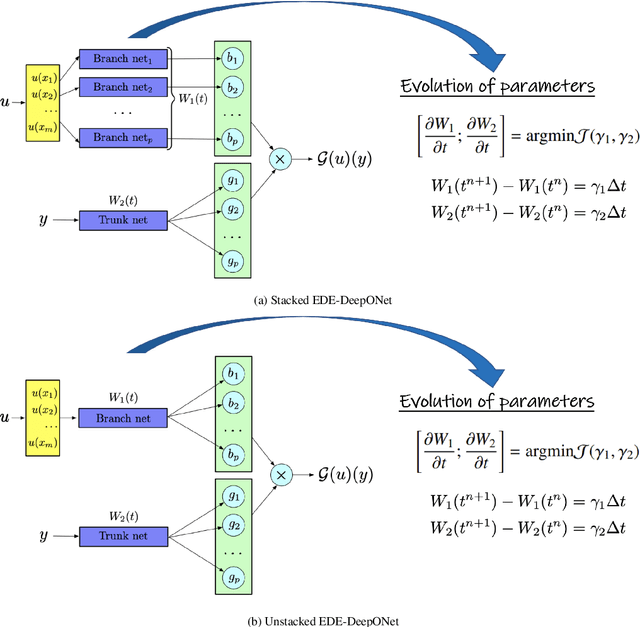

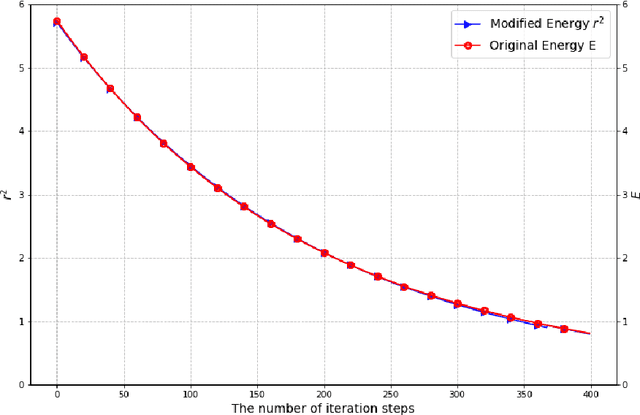

Abstract:Energy-Dissipative Evolutionary Deep Operator Neural Network is an operator learning neural network. It is designed to seed numerical solutions for a class of partial differential equations instead of a single partial differential equation, such as partial differential equations with different parameters or different initial conditions. The network consists of two sub-networks, the Branch net and the Trunk net. For an objective operator G, the Branch net encodes different input functions u at the same number of sensors, and the Trunk net evaluates the output function at any location. By minimizing the error between the evaluated output q and the expected output G(u)(y), DeepONet generates a good approximation of the operator G. In order to preserve essential physical properties of PDEs, such as the Energy Dissipation Law, we adopt a scalar auxiliary variable approach to generate the minimization problem. It introduces a modified energy and enables unconditional energy dissipation law at the discrete level. By taking the parameter as a function of time t, this network can predict the accurate solution at any further time with feeding data only at the initial state. The data needed can be generated by the initial conditions, which are readily available. In order to validate the accuracy and efficiency of our neural networks, we provide numerical simulations of several partial differential equations, including heat equations, parametric heat equations and Allen-Cahn equations.
Attribute-Efficient PAC Learning of Low-Degree Polynomial Threshold Functions with Nasty Noise
Jun 01, 2023Abstract:The concept class of low-degree polynomial threshold functions (PTFs) plays a fundamental role in machine learning. In this paper, we study PAC learning of $K$-sparse degree-$d$ PTFs on $\mathbb{R}^n$, where any such concept depends only on $K$ out of $n$ attributes of the input. Our main contribution is a new algorithm that runs in time $({nd}/{\epsilon})^{O(d)}$ and under the Gaussian marginal distribution, PAC learns the class up to error rate $\epsilon$ with $O(\frac{K^{4d}}{\epsilon^{2d}} \cdot \log^{5d} n)$ samples even when an $\eta \leq O(\epsilon^d)$ fraction of them are corrupted by the nasty noise of Bshouty et al. (2002), possibly the strongest corruption model. Prior to this work, attribute-efficient robust algorithms are established only for the special case of sparse homogeneous halfspaces. Our key ingredients are: 1) a structural result that translates the attribute sparsity to a sparsity pattern of the Chow vector under the basis of Hermite polynomials, and 2) a novel attribute-efficient robust Chow vector estimation algorithm which uses exclusively a restricted Frobenius norm to either certify a good approximation or to validate a sparsity-induced degree-$2d$ polynomial as a filter to detect corrupted samples.
Learning Large Scale Sparse Models
Jan 26, 2023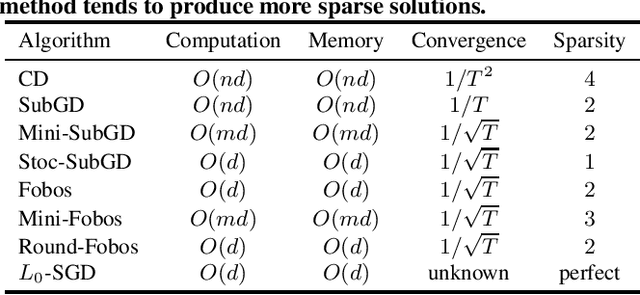
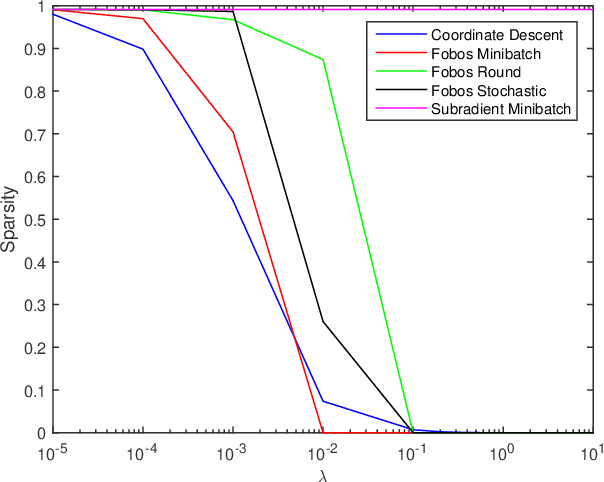
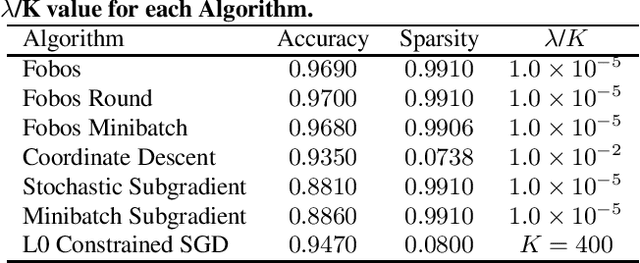
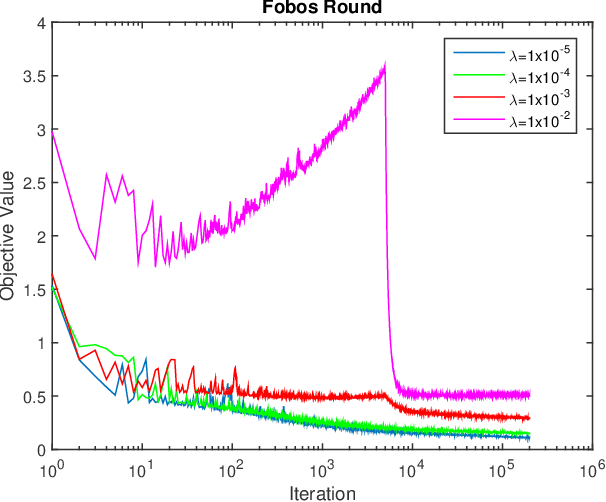
Abstract:In this work, we consider learning sparse models in large scale settings, where the number of samples and the feature dimension can grow as large as millions or billions. Two immediate issues occur under such challenging scenario: (i) computational cost; (ii) memory overhead. In particular, the memory issue precludes a large volume of prior algorithms that are based on batch optimization technique. To remedy the problem, we propose to learn sparse models such as Lasso in an online manner where in each iteration, only one randomly chosen sample is revealed to update a sparse iterate. Thereby, the memory cost is independent of the sample size and gradient evaluation for one sample is efficient. Perhaps amazingly, we find that with the same parameter, sparsity promoted by batch methods is not preserved in online fashion. We analyze such interesting phenomenon and illustrate some effective variants including mini-batch methods and a hard thresholding based stochastic gradient algorithm. Extensive experiments are carried out on a public dataset which supports our findings and algorithms.
FAN-Trans: Online Knowledge Distillation for Facial Action Unit Detection
Nov 11, 2022Abstract:Due to its importance in facial behaviour analysis, facial action unit (AU) detection has attracted increasing attention from the research community. Leveraging the online knowledge distillation framework, we propose the ``FANTrans" method for AU detection. Our model consists of a hybrid network of convolution and transformer blocks to learn per-AU features and to model AU co-occurrences. The model uses a pre-trained face alignment network as the feature extractor. After further transformation by a small learnable add-on convolutional subnet, the per-AU features are fed into transformer blocks to enhance their representation. As multiple AUs often appear together, we propose a learnable attention drop mechanism in the transformer block to learn the correlation between the features for different AUs. We also design a classifier that predicts AU presence by considering all AUs' features, to explicitly capture label dependencies. Finally, we make the attempt of adapting online knowledge distillation in the training stage for this task, further improving the model's performance. Experiments on the BP4D and DISFA datasets demonstrating the effectiveness of proposed method.
* 9 pages, 6 figures
 Add to Chrome
Add to Chrome Add to Firefox
Add to Firefox Add to Edge
Add to Edge